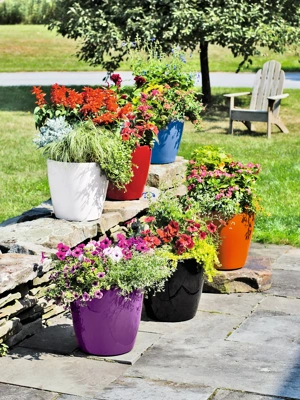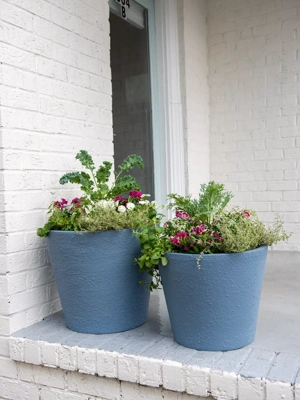Growing Brugmansias
Also known as angel's trumpets, these beauties are worth saving from year to year

This plant was bought in an 8-inch pot in spring and repotted into a 12" pot.
For high drama in the garden, there's nothing quite like a brugmansia in full bloom. Known as the angel's trumpet, this show-stopper has 6" to 10" blooms that dangle from sturdy branches. In one season, these shrubby, subtropical plants can easily reach 6'. A plant that's been saved from season to season will grow even taller, producing flushes of bloom that can include dozens of flowers.
Because of their beauty, brugmansias are worth saving from year to year. It's easy.
You'll find brugmansias at garden centers in spring — usually sold with the annuals. Grow the plant in a container and fertilize regularly. Because these plants are thirsty, invest in a self-watering pot.
In late summer or fall, when temperatures drop near freezing, cut back on watering and stop fertilizing. Before the first frost, move the brugmansia into storage to go dormant. All you need is a cool, dark, frost-free place — 30 to 45 degrees F. is ideal. I keep mine in the cellar. Water it occasionally through the winter to keep the root ball barely moist.
In spring, when nighttime temperatures are not predicted to dip below 32 degrees F., bring the plant out and repot it, as described in the photos, below.

After a winter in the dark basement, a brugmansia looks pretty ragged. Hard to believe there is any life in it, but the pale green shoot at the base shows promise.

Overwintered brugmansias will grow from the roots, as this shoot shows, and from last year's woody growth.

Remove the plant from its pot and rejuvenate it by teasing out the roots with your fingers. Don't be worried if you break a few roots. This technique, called "root-pruning," doesn't harm the plant.

Use a soil knife or trowel to break apart dense masses of roots. I plan to use a pot that's the same size as last season, so I'm trimming about 2" from the original root ball.

When finished, the root ball looks a little rough — and considerably smaller. Fresh soil, fertilizer and water will jumpstart the dormant plant.

When finished, the root ball looks a little rough — and considerably smaller. Fresh soil, fertilizer and water will jumpstart the dormant plant.

Position the trimmed root ball in the pot so that the soil surface will be a couple inches below the rim. Make sure the root ball is firmly seated in the new soil. Water thoroughly to settle the soil.

Usually there is some die-back during the winter, so you'll have to prune a few inches off the tips. To tell if your branch is still viable, scrape the bark with the blade of your pruners to see if there is a bright green layer just below the surface.

Prune as you wish. I prune into an open vase shape. New growth will support the dangling, trumpet-shaped blooms.
Tips

- Repot with pre-moistened, fresh potting soil. Do not use garden soil because it will not drain freely. Mix some slow-release granular fertilizer into the soil. as you fill the pot.
- When new growth begins, fertilize regularly with liquid fertilizer. I like fish-based fertilizer, which I use every week. Whatever you choose, follow the recommendations on the fertilizer's label. Regular fertilizing and watering makes the difference between a nice plant and a spectacular plant.
- Remove spent flowers to keep the plant tidy. Brugmansias usually bloom in flushes, several weeks apart.
- Brugmansias love hot weather, but keep an eye on watering. They can dry out quickly and will wilt in protest. A self-watering pot will make a big difference. When watering, the goal is to keep the soil moist, but not soggy. During the hottest part of the summer, you will probably have to water every day. To make watering easier, consider sinking the pot into a garden bed, which will help the plant retain moisture.
- Brugmansias do best in full sun.
- All plant parts are poisonous; keep brugmansias away from inquisitive children and pets. Learn more about brugmansia toxicity.
- The flowers are most fragrant at night, so put plants where the tropical scent can be enjoyed most.
Last updated: 06/28/2023
Print this Article:
Related items
Get the Dirt
Stay up to date on new articles and advice. Please fill out the information below.











